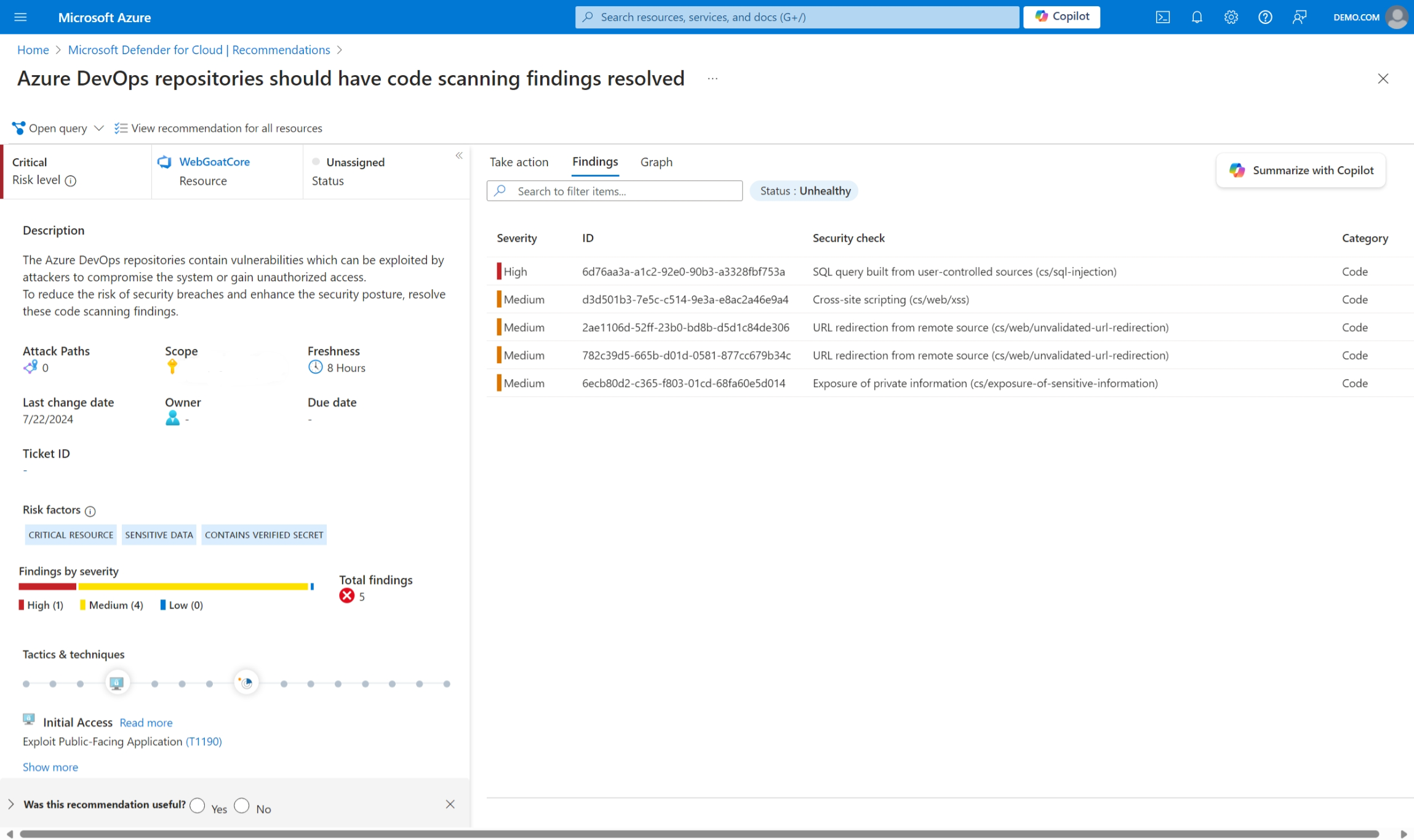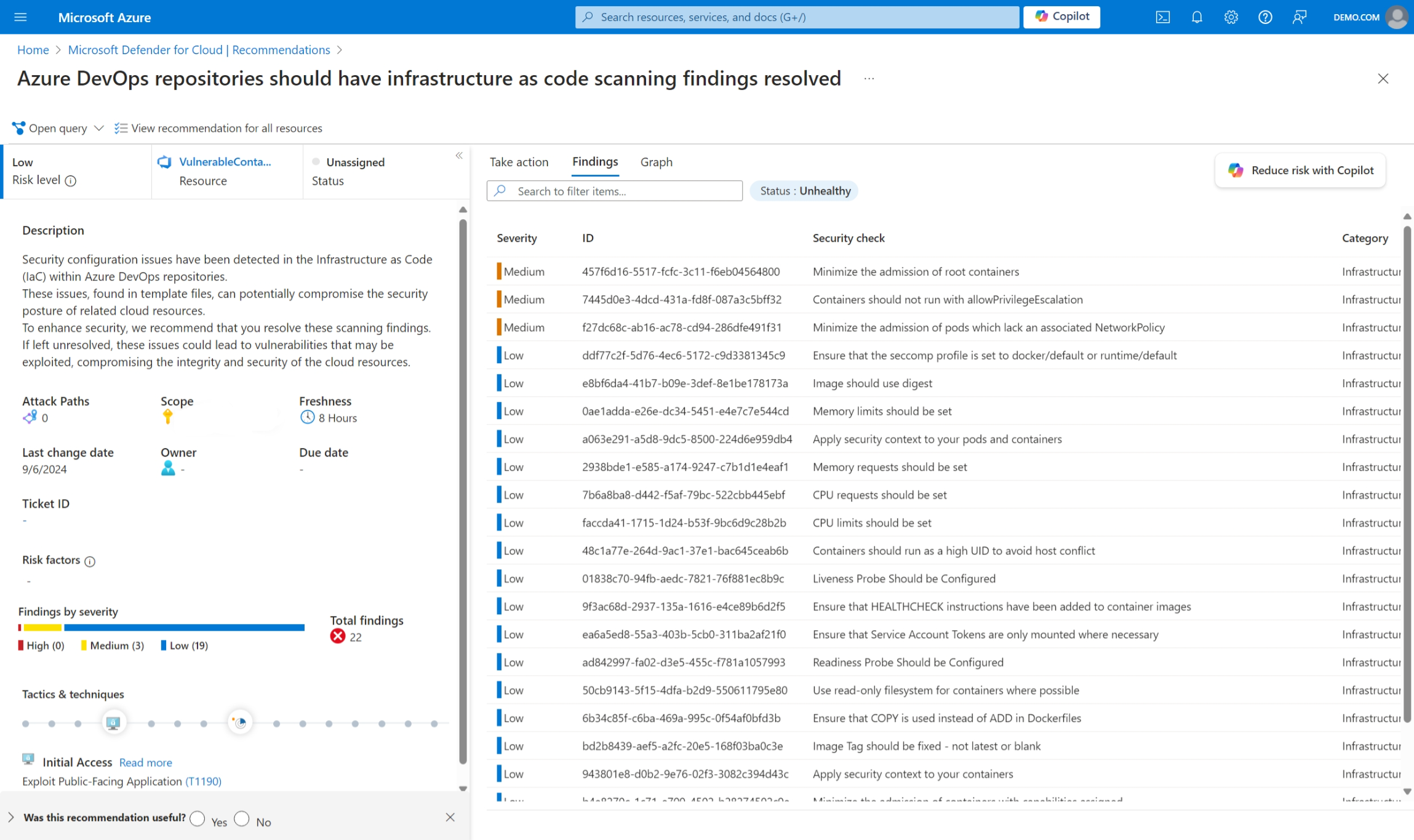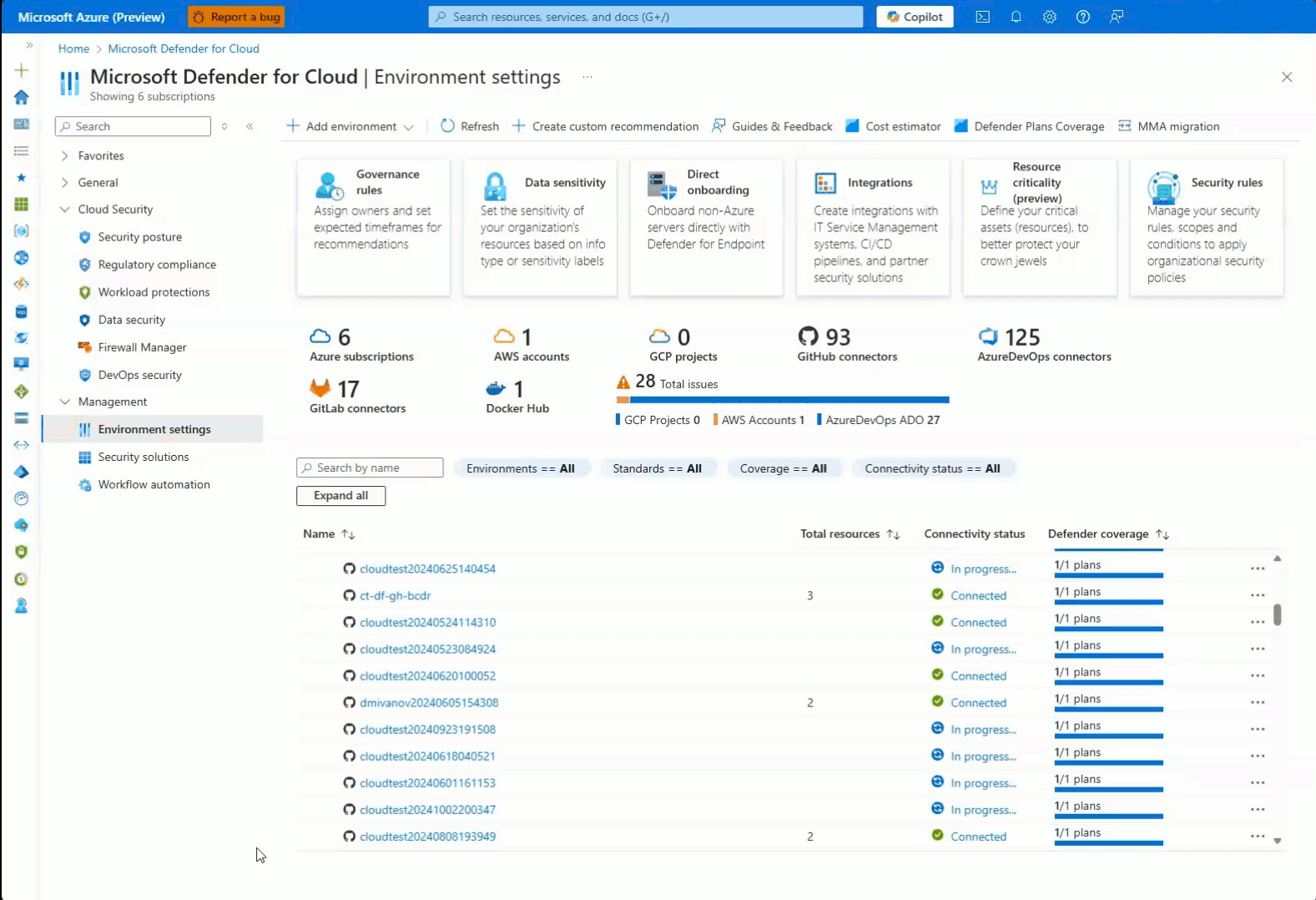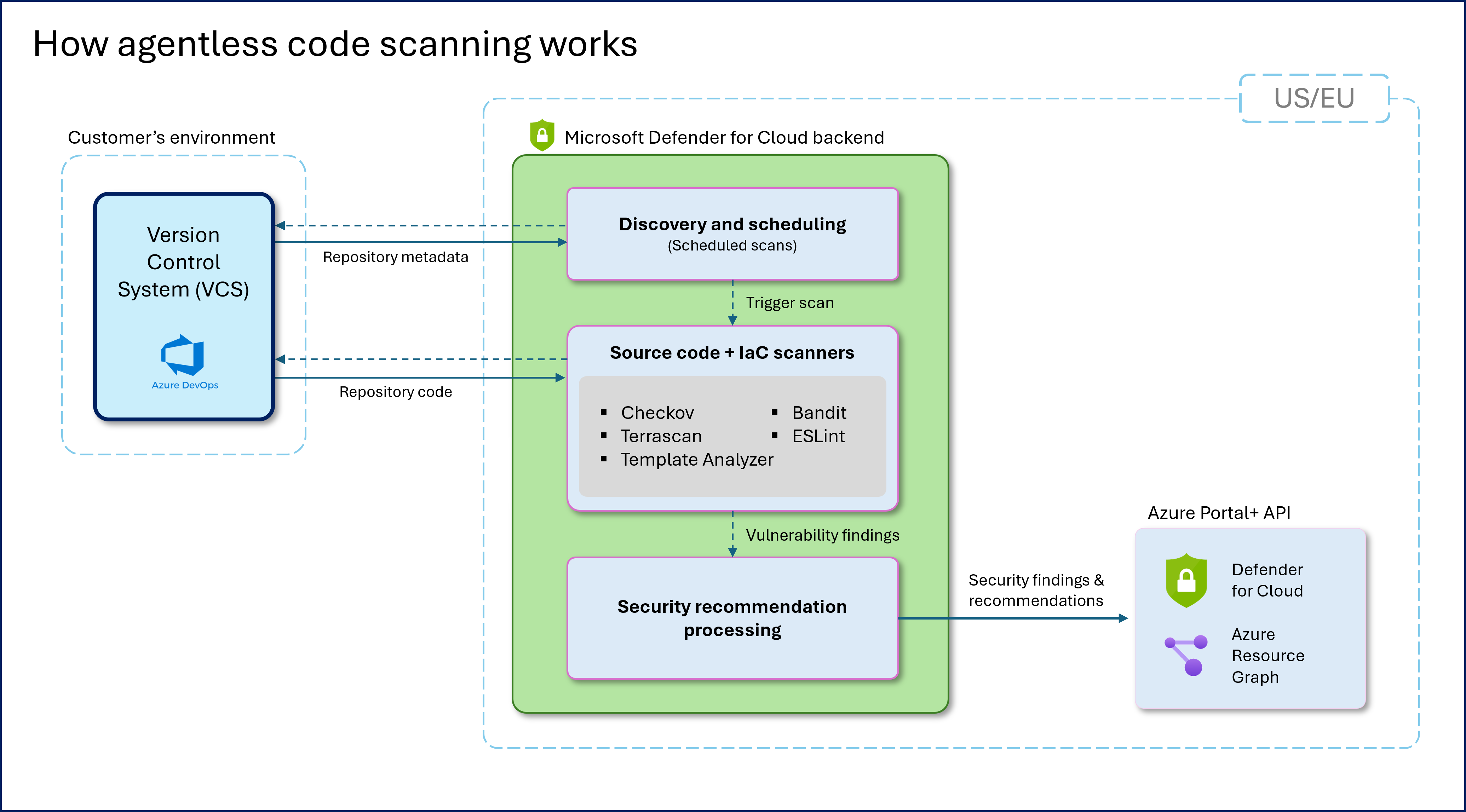Agentless code scanning in Microsoft Defender for Cloud
Agentless code scanning in Microsoft Defender for Cloud offers fast and scalable security coverage for all repositories in Azure DevOps. It quickly finds vulnerabilities in code and infrastructure-as-code (IaC) setups without needing agents or Continuous Integration and Continuous Deployment (CI/CD) pipeline changes. This approach simplifies setup and maintenance with a single Azure DevOps connector, and provides broad coverage, continuous insights, and actionable security findings. It lets security and development teams focus on fixing risks smoothly without interrupting development workflows.
Prerequisites
Release state: Public preview
Supported use cases:
Clouds: Azure commercial clouds
Supported regions: Australia East, Canada Central, Central US, East Asia, East US, North Europe, Sweden Central, UK South, West Europe
Supported environments: Azure DevOps connector
Roles and permissions:
To set up and configure the connector:
- Project Collection Admin: Required in Azure DevOps to perform the initial setup.
- Subscription Contributor: Needed on the Azure subscription to create and configure the connector.
To view security results:
- Security Admin: Can manage security settings, policies, and alerts but can't modify the connector.
- Security Reader: Can view recommendations, alerts, and policies but can't make any changes.
Key benefits
- Proactive risk management: Identify risks early in the development process. This supports secure coding practices and reduces vulnerabilities before they reach production.
- Effortless onboarding: Set up quickly with minimal configuration and no pipeline changes.
- Enterprise-scale, centralized management: Automatically scan code across multiple repositories using a single connector. This provides extensive coverage for large environments.
- Rapid insights for quick remediation: Receive actionable vulnerability insights right after onboarding. This enables quick fixes and reduces exposure time.
- Developer-friendly and seamless: Operate independently of continuous integration and continuous deployment (CI/CD) pipelines, with no changes or direct developer involvement needed. This allows for continuous security monitoring without disrupting developer productivity or workflows.
Risks detection capabilities
Agentless code scanning improves security by offering targeted security recommendations for both code and Infrastructure-as-Code (IaC) templates. This is in addition to Foundational Cloud Security Posture Management (CSPM) security recommendations provided through the connector. Key detection abilities include:
- Code vulnerabilities: Find common coding errors, unsafe coding practices, and known vulnerabilities in multiple programming languages.
- Infrastructure-as-Code misconfigurations: Detect security misconfigurations in IaC templates that could lead to insecure deployments.
Creating the connector enhances security by providing a foundational set of security recommendations for repositories, pipelines, and service connections.
Scanning tools
Agentless code scanning uses various open-source tools to find vulnerabilities and misconfigurations in code and Infrastructure-as-Code (IaC) templates:
| Tool | Supported IaC/Languages | License |
|---|---|---|
| Bandit | Python | Apache 2.0 |
| Checkov | Terraform IaC templates, Terraform plan files, AWS CloudFormation templates, Kubernetes manifest files, Helm chart files, Dockerfiles, Azure Azure Resource Manager (ARM) IaC templates, Azure Bicep IaC templates, AWS SAM templates (Serverless Application Model), Kustomize files, Serverless framework templates, OpenAPI specification files | Apache 2.0 |
| ESLint | JavaScript, TypeScript, JSX, TSX | MIT |
| Template Analyzer | ARM IaC templates, Bicep IaC templates | MIT |
These tools support a wide range of languages and IaC frameworks, ensuring thorough security analysis across your codebase.
Supported platforms and file types
Version control systems
- Azure DevOps: Full support for repositories connected via the Azure DevOps connector.
Programming languages
- Python
- JavaScript/TypeScript
Infrastructure-as-Code (IaC) platforms and configurations
| IaC Platform | Supported file types | Notes |
|---|---|---|
| Terraform | .tf, .tfvars |
Supports Terraform IaC templates in HCL2 language, including variable files in .tfvars. |
| Terraform Plan | JSON files | Includes JSON files representing planned configurations, used for analysis and scanning. |
| AWS CloudFormation | JSON, YAML files | Supports AWS CloudFormation templates for defining AWS resources. |
| Kubernetes | YAML, JSON files | Supports Kubernetes manifest files for defining configurations in clusters. |
| Helm | Helm chart directory structure, YAML files | Follows Helm’s standard chart structure; supports Helm v3 chart files. |
| Docker | Files named Dockerfile | Supports Dockerfiles for container configurations. |
| Azure ARM Templates | JSON files | Supports Azure Resource Manager (ARM) IaC templates in JSON format. |
| Azure Bicep | .bicep files | Supports Bicep IaC templates, a domain-specific language (DSL) for ARM. |
| AWS SAM | YAML files | Supports AWS Serverless Application Model (SAM) templates for serverless resources. |
| Kustomize | YAML files | Supports configuration files for Kubernetes customization (Kustomize). |
| Serverless Framework | YAML files | Supports templates for the Serverless framework in defining serverless architectures. |
| OpenAPI | YAML, JSON files | Supports OpenAPI specification files for defining RESTful APIs. |
Enable agentless code scanning on your Azure DevOps organizations
To connect your Azure DevOps organizations to Defender for Cloud and enable agentless code scanning, refer to the instructions in Connect your Azure DevOps organizations. The following visual shows the quick, straightforward setup process, guiding you through each step for seamless onboarding.
How agentless code scanning works
Agentless code scanning works independently of CI/CD pipelines. It uses the Azure DevOps connector to automatically scan code and Infrastructure-as-Code (IaC) configurations. You don't need to modify pipelines or add extensions. This setup enables broad and continuous security analysis across multiple repositories. Results are processed and shown directly in Microsoft Defender for Cloud.
Scanning process
Once you enable the agentless code scanning feature within a connector, the scanning process follows these steps:
- Repository discovery: The system automatically identifies all repositories linked through the Azure DevOps connector right after connector creation and then every 8 hours.
- Code retrieval: It securely retrieves the latest code from the default (main) branch of each repository for analysis, first after connector setup and then every 3-4 days.
- Analysis: The system uses a set of built-in scanning tools managed and updated within Microsoft Defender for Cloud to find vulnerabilities and misconfigurations in code and IaC templates.
- Findings processing: It processes scan findings through Defender for Cloud’s backend to create actionable security recommendations.
- Results delivery: The system shows findings as security recommendations in Defender for Cloud, allowing security teams to review and address issues.
Scan frequency and duration
- Scan frequency:
- The security posture of repositories, pipelines, and service connections is assessed when you create the connector and then every 8 hours.
- The system scans code and Infrastructure-as-Code (IaC) templates for vulnerabilities after you create the connector and then every 3-4 days.
- Scan duration: Scans typically finish within 15 to 60 minutes, depending on the size and complexity of the repository.
View and manage scan results
After the scans finish, you can access security findings within Microsoft Defender for Cloud.
Access findings
Navigate to the Security recommendations tab in Microsoft Defender for Cloud.
Review the list of recommendations, which includes findings like:
Azure DevOps repositories should have code scanning findings resolved - Indicates vulnerabilities found in code repositories.

Azure DevOps repositories should have infrastructure as code scanning findings resolved - Points to security misconfigurations detected in IaC template files within repositories.

Other security recommendations generated by the Azure DevOps connector might include:
- Azure DevOps repositories should have GitHub Advanced Security for Azure DevOps (GHAzDO) enabled
- Azure Pipelines shouldn't have secrets available to builds of forks
- Azure DevOps service connections shouldn't grant access to all pipelines
- Azure DevOps variable groups with secret variables shouldn't grant access to all pipelines
- Azure DevOps Classic Azure service connections shouldn't be used to access a subscription
- (Preview) Azure DevOps repositories should require minimum two-reviewer approval for code pushes
- (Preview) Azure DevOps repositories should not allow requestors to approve their own pull requests
- (Preview) Azure DevOps Projects should have creation of classic pipelines disabled
- Azure DevOps secure files shouldn't grant access to all pipelines
Select any recommendation for detailed information, including affected files, severity levels, and remediation guidance.
Difference between agentless code scanning and in-pipeline scanning
Agentless code scanning and in-pipeline scanning using the Microsoft Security DevOps extension both offer security scanning within Azure DevOps. They serve different needs but work well together. The following table highlights the main differences to help you choose the option that fits your security and development needs.
| Aspect | Agentless code scanning | In-pipeline scanning |
|---|---|---|
| Use case fit | Offers broad coverage with minimal disruption to developers | Provides detailed, pipeline-integrated scans with customizable controls |
| Scan scope and coverage | Focuses on Infrastructure-as-Code (IaC) and code vulnerability scanning, scheduled every 3-4 days | Offers extensive coverage, including binaries and container images, triggered on each pipeline run |
| Setup and configuration | Requires no further setup after creating the connector | Requires manual installation and configuration in each CI/CD pipeline |
| Pipeline integration | Runs independently of (CI/CD) pipelines without modifying workflows | Integrates within the CI/CD pipeline, requiring configuration in each pipeline |
| Scanner customization | Scanners can't be customized or selectively run | Allows customization with specific scanners, categories, languages, sensitivity levels, and non-Microsoft tools |
| Results and feedback | Provides access to findings within Defender for Cloud | Offers near real-time feedback within the CI/CD pipeline, with results also visible in Defender for Cloud |
| Break and fail criteria | Can't break builds | Can be configured to break builds based on the severity of security findings |
Scalability and performance impact
Agentless code scanning avoids creating resources in the subscription and doesn't require scanning during the pipeline process. It uses the Azure DevOps REST API to pull metadata and code. This means API calls count toward Azure DevOps rate limits, but you don't incur direct data transfer costs. The service manages scans to ensure they stay within Azure DevOps rate limits without interrupting the development environment. This method provides efficient, high-performance scanning across repositories without affecting DevOps workflows. For more information, see Azure DevOps Rate and Usage Limits.
Data security, compliance, and access control for agentless code scanning
Microsoft Defender for Cloud’s agentless code scanning service ensures secure and compliant handling of your code by implementing strict data security and privacy measures:
- Data encryption and access control: The system encrypts all data in transit using industry-standard protocols. Only authorized Defender for Cloud services can access your code.
- Data residency and retention: Scans occur in the same geo as your Azure DevOps connector (US or EU) to comply with data protection laws. The system processes code only during scanning and securely deletes it afterward, with no long-term storage.
- Access to repositories: The service generates a secure access token for Azure DevOps to perform scans. This token enables retrieval of necessary metadata and code without creating resources in your subscription. Only Defender for Cloud components have access, protecting data integrity.
- Compliance support: The service aligns with regulatory and security standards for data handling and privacy, ensuring secure processing and scanning of customer code in compliance with regional data protection requirements.
These measures ensure a secure, compliant, and efficient code scanning process, maintaining your data’s privacy and integrity.
Limitations (public preview)
During the public preview phase, the following limitations apply:
No binary scanning: The system scans only code and Infrastructure-as-Code (IaC) files.
Scan frequency: It scans repositories every 3 days.
Repository size: It limits scanning to repositories under 1 GB.
Branch coverage: Scans cover only the default (main) branch.
Tool customization: You can't customize scanning tools.

